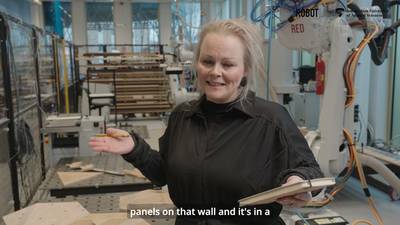Uitwerking van het smart industry ecosysteem voor onderwijs en arbeid. Hierin aandacht voor Smart Industry en Formeel leren, Leven Lang Leren, flexibilisering en Learning by doing.
DOCUMENT

Eindrapportage Smart Industry Hub Noord Nederland
DOCUMENT

In recent years, a step change has been seen in the rate of adoption of Industry 4.0 technologies by manufacturers and industrial organizations alike. This article discusses the current state of the art in the adoption of Industry 4.0 technologies within the construction industry. Increasing complexity in onsite construction projects coupled with the need for higher productivity is leading to increased interest in the potential use of Industry 4.0 technologies. This article discusses the relevance of the following key Industry 4.0 technologies to construction: data analytics and artificial intelligence, robotics and automation, building information management, sensors and wearables, digital twin, and industrial connectivity. Industrial connectivity is a key aspect as it ensures that all Industry 4.0 technologies are interconnected allowing the full benefits to be realized. This article also presents a research agenda for the adoption of Industry 4.0 technologies within the construction sector, a three-phase use of intelligent assets from the point of manufacture up to after build, and a four-staged R&D process for the implementation of smart wearables in a digital enhanced construction site.
DOCUMENT

How can a smart ‘upcycle wood factory’ (powered by industry 4.0 technologies and principles) help create meaningful and viable applications out of residual wood applicable to the hospitality sector?This video gives the answers.
YOUTUBE

An interview with HU researcher Beverly Pasian on smart cities, projects and urban life.
LINK
Contribution to conference magazine https://husite.nl/ssc2017/ Conference ‘Smart Sustainable Cities 2017 – Viable Solutions’ The conference ‘Smart Sustainable Cities 2017 – Viable Solutions’ was held on 14 June 2017 in Utrecht, the Netherlands. Over 250 participants from all over Europe attended the conference.
DOCUMENT

From the list of content: " Smart sustainable cities & higher education, Essence: what, why & how? Developing learning materials together; The blended learning environment; Teaching on entrepreneurship; Utrecht municipality as a client; International results; Studentexperiences; International relations; City projects in Turku, Alcoy and Utrecht ".
DOCUMENT

Design educators and industry partners are critical knowledge managers and co-drivers of change, and design graduate and post-graduate students can act as catalysts for new ideas, energy, and perspectives. In this article, we will explore how design advances industry development through the lens of a longitudinal inquiry into activities carried out as part of a Dutch design faculty-industry collaboration. We analyze seventy-five (75) Master of Science (MSc) thesis outcomes and seven (7) Doctorate (PhD) thesis outcomes (five in progress) to identify ways that design activities have influenced advances in the Dutch aviation industry over time. Based on these findings, we then introduce an Industry Design Framework, which organizes the industry/design relationship as a three-layered system. This novel approach to engaging industry in design research and design education has immediate practical value and theoretical significance, both in the present and for future research. https://doi.org/10.1016/j.sheji.2019.07.003 LinkedIn: https://www.linkedin.com/in/christine-de-lille-8039372/
MULTIFILE

The role of smart cities in order to improve older people’s quality of life, sustainability and opportunities, accessibility, mobility, and connectivity is increasing and acknowledged in public policy and private sector strategies in countries all over the world. Smart cities are one of the technological-driven initiatives that may help create an age-friendly city. Few research studies have analysed emerging countries in terms of their national strategies on smart or age-friendly cities. In this study, Romania which is predicted to become one of the most ageing countries in the European Union is used as a case study. Through document analysis, current initiatives at the local, regional, and national level addressing the issue of smart and age-friendly cities in Romania are investigated. In addition, a case study is presented to indicate possible ways of the smart cities initiatives to target and involve older adults. The role of different stakeholders is analysed in terms of whether initiatives are fragmentary or sustainable over time, and the importance of some key factors, such as private–public partnerships and transnational bodies. The results are discussed revealing the particularities of the smart cities initiatives in Romania in the time frame 2012–2020, which to date, have limited connection to the age-friendly cities agenda. Based on the findings, a set of recommendations are formulated to move the agenda forward. CC-BY Original article: https://doi.org/10.3390/ijerph17145202 (This article belongs to the Special Issue Feature Papers "Age-Friendly Cities & Communities: State of the Art and Future Perspectives") https://www.dehaagsehogeschool.nl/onderzoek/lectoraten/details/urban-ageing#over-het-lectoraat
MULTIFILE

Expectations are high with regards to smart home technology. In particular, smart home technology is expected to support or enable independent living by older adults. This raises the question: can smart home technology contribute to independent living, according to older adults themselves? This chapter aims to answer this question by reviewing and discussing older adults’ perspectives on independence and their views on smart home technology. Firstly, older adults’ opinions on independence and aging in place are discussed. Secondly, this chapter will review to what extent smart home technology can support older adults’ independence. Thirdly, it will be explained how community-dwelling older adults’ concept of independence entails three distinct types or modes, and how these modes are related to their perceptions and acceptance of technology. In the last section of this chapter, an overview of key points is presented, and recommendations for technology designers, policy makers, and care providers are postulated.
LINK